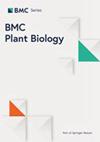Novel resistance loci for quantitative resistance to Septoria tritici blotch in Asian wheat (Triticum aestivum) via genome-wide association study
IF 4.3
2区 生物学
Q1 PLANT SCIENCES
引用次数: 0
Abstract
Septoria tritici blotch (STB) disease causes yield losses of up to 50 per cent in susceptible wheat cultivars and can reduce wheat production. In this study, genomic architecture for adult-plant STB resistance in a Septoria Association Mapping Panel (SAMP) having 181 accessions and genomic regions governing STB resistance in a South Asian wheat panel were looked for. Field experiments during the period from 2019 to 2021 revealed those certain accessions, namely BGD52 (CHIR7/ANB//CHIR1), BGD54 (CHIR7/ANB//CHIR1), IND92 (WH 1218), IND8 (DBW 168), and IND75 (PBW 800), exhibited a high level of resistance. Genetic analysis revealed the presence of 21 stable quantitative trait nucleotides (QTNs) associated with resistance to STB (Septoria tritici blotch) on all wheat chromosomes, except for 2D, 3A, 3D, 4A, 4D, 5D, 6B, 6D, and 7A. These QTNs were predominantly located in chromosome regions previously identified as associated with STB resistance. Three Quantitative Trait Loci (QTNs) were found to have significant phenotypic effects in field evaluations. These QTNs are Q.STB.5A.1, Q.STB.5B.1, and Q.STB.5B.3. Furthermore, it is possible that the QTNs located on chromosomes 1A (Q.STB.1A.1), 2A (Q.STB_DH.2A.1, Q.STB.2A.3), 2B (Q.STB.2B.4), 5A (Q.STB.5A.1, Q.STB.5A.2), and 7B (Q.STB.7B.2) could potentially be new genetic regions associated with resistance. Our findings demonstrate the importance of Asian bread wheat as a source of STB resistance alleles and novel stable QTNs for wheat breeding programs aiming to develop long-lasting and wide-ranging resistance to Zymoseptoria tritici in wheat cultivars.通过全基因组关联研究发现亚洲小麦(Triticum aestivum)对赤霉病(Septoria tritici blotch)定量抗性的新抗性位点
三尖孢(Septoria tritici)斑点病(STB)会使易感病的小麦品种减产高达 50%,并导致小麦减产。在这项研究中,研究人员在拥有181个品种的Septoria关联图谱组(SAMP)中寻找了成株STB抗性的基因组结构,并在南亚小麦图谱组中寻找了管理STB抗性的基因组区域。2019 年至 2021 年期间的田间试验显示,某些品种,即 BGD52 (CHIR7/ANB//CHIR1)、BGD54 (CHIR7/ANB//CHIR1)、IND92 (WH 1218)、IND8 (DBW 168) 和 IND75 (PBW 800),表现出高水平的抗性。遗传分析表明,除 2D、3A、3D、4A、4D、5D、6B、6D 和 7A 外,所有小麦染色体上都存在 21 个与 STB(三尖杉斑病)抗性相关的稳定数量性状核苷酸(QTN)。这些 QTN 主要位于先前确定的与 STB 抗性相关的染色体区域。在田间评估中发现,有三个数量性状基因座(QTN)具有显著的表型效应。这些 QTN 分别是 Q.STB.5A.1、Q.STB.5B.1 和 Q.STB.5B.3。此外,位于 1A(Q.STB.1A.1)、2A(Q.STB_DH.2A.1、Q.STB.2A.3)、2B(Q.STB.2B.4)、5A(Q.STB.5A.1、Q.STB.5A.2)和 7B(Q.STB.7B.2)染色体上的 QTN 有可能是与抗性相关的新遗传区域。我们的研究结果表明,亚洲面包小麦是 STB 抗性等位基因和新的稳定 QTN 的重要来源,这对旨在开发小麦栽培品种对三尖杉属胸腺丝核菌的长效和广泛抗性的小麦育种计划非常重要。
本文章由计算机程序翻译,如有差异,请以英文原文为准。
求助全文
约1分钟内获得全文
求助全文
来源期刊

BMC Plant Biology
生物-植物科学
CiteScore
8.40
自引率
3.80%
发文量
539
审稿时长
3.8 months
期刊介绍:
BMC Plant Biology is an open access, peer-reviewed journal that considers articles on all aspects of plant biology, including molecular, cellular, tissue, organ and whole organism research.
 求助内容:
求助内容: 应助结果提醒方式:
应助结果提醒方式:


